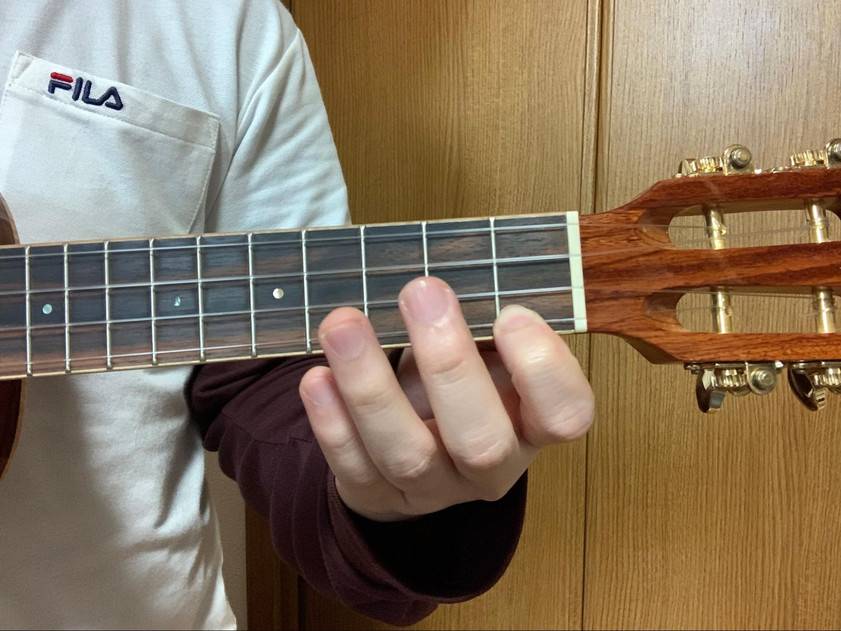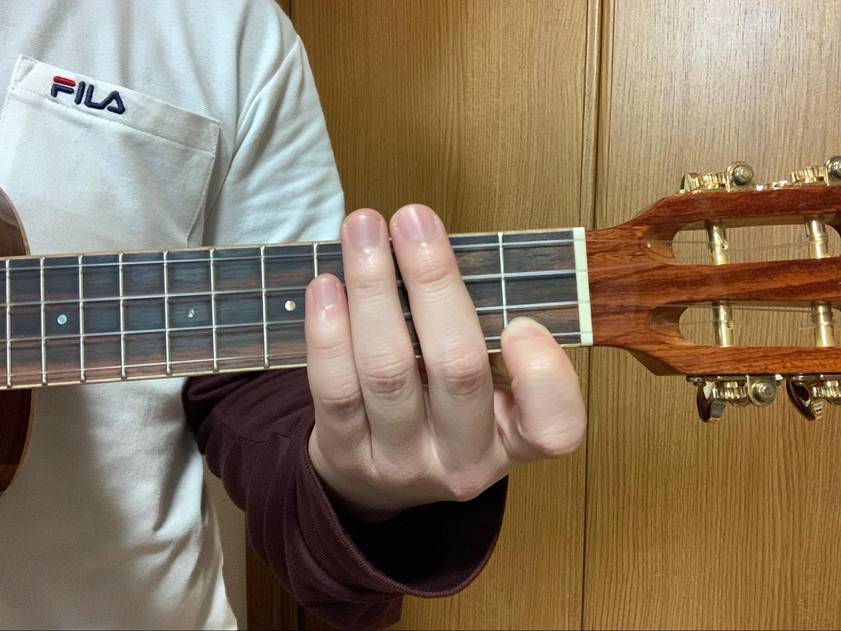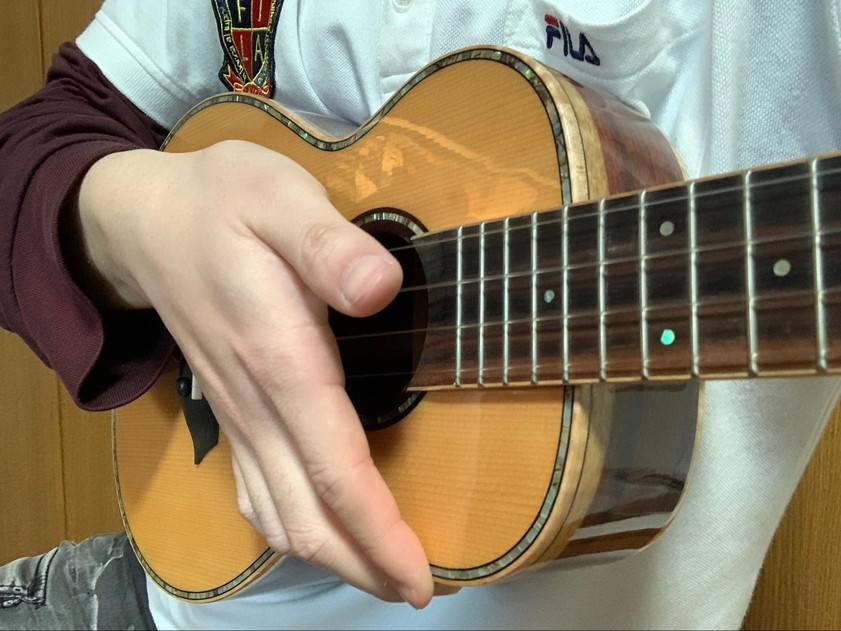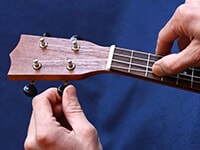Hello, this is Conservario.
When it comes to playing the ukulele, many people think that producing sound is the only thing that matters.
Playing melodies, strumming chords, and making strokes are all actions that produce sound.
However, in reality, muting or stopping the sound is just as important as producing it. I will introduce the methods and practical exercises for this.
I will introduce the methods and form for muting the sound.
There are two main ways:
Muting with the left hand and muting with the right hand.
■ Muting with the Left Hand
For this example, we’ll play the C7 chord.
To play the C7 chord, press the 1st fret on the 1st string with your index finger.
Let’s try playing it once.
Strum... Now, you’ve played and sustained the C7 chord.
However, once you’ve produced a sound, you also need to stop it.
The sound won’t keep going forever on its own, but leaving it to fade away is not musical, and it keeps you in the beginner stage.
You need to consciously decide when to stop the sound and practice stopping at the right moments.
Now, let’s move on to how to stop the sound.
When pressing the C7 chord, only the index finger is pressing.
The middle, ring, and pinky fingers aren’t pressing anything.
Use these three fingers.
After you strum, lightly touch these three fingers to the strings, and the sound will stop.


What you need to be careful of here is that the three fingers should only touch the strings, not press them.
If you press too hard with all three fingers, the sound won’t stop.
In fact, if you strike the strings too aggressively, the sound will continue.
If you end up making a sound where you should be stopping it, it defeats the purpose.
Practice getting used to the light touch of these three fingers.
■ Muting with the Right Hand
Once you’re able to mute with the left hand, let’s practice muting with the right hand as well.
For chords like C7, which you can play with just one finger, you can mute using the remaining three fingers.
However, for some chords, you might not have spare fingers.
For example, let’s take the G7 chord.
To play G7, press the 2nd fret of the 3rd string, the 1st fret of the 2nd string, and the 2nd fret of the 1st string.
Normally, with this finger positioning, you’re already using three fingers, and only the pinky is left.
It’s not easy to mute with just the pinky.
In such cases, you can mute with the right hand.
This method might be simpler than muting with the left hand.
After strumming, place the edge of your right hand (the side of your palm) lightly on the strings.

This will stop the sound.
This method of muting with the right hand is more common, so many of you might have already tried it.
What to be careful of is making sure the right hand touches all four strings.
If you casually place your hand on the strings, you may miss one or two strings, and the sound will continue on those strings.
Naturally, the sound will continue to sustain, and the one string that is still ringing will stand out.
Make sure the side of your right hand touches all four strings.
■ Conclusion
I’ve introduced two methods for muting the sound.
As I’ve mentioned in previous columns, properly muting the sound is crucial.
Readers might have heard someone’s performance and thought, “That sounds great!” or “Something feels off.”
The reason for this can vary, but a person who is good at muting the sound will generally sound better.
On the other hand, those who can play various chords or complex notes but sound off often have poor or inconsistent muting techniques.
Whether you’re strumming or playing solo ukulele, this muting skill will be helpful.
For example, let’s say you’re doing a simple four downstrokes.
If you just strum four times in a row, the performance might become boring. But if you change the length of the notes and the timing of when to stop them, it will create a more interesting, musical performance. For instance, Strum... Strum... Strum, will sound much more musical and engaging.
Of course, simple playing isn’t bad, but if you aim for a musical performance, knowing when to stop the sound is incredibly important.
Practice isn’t just about producing sound and increasing your technical ability.
The ability to stop or reduce sound, as I’ve shown today, is something you should practice as well.
Those who are skilled at playing understand the importance of this, so they make sure to play the parts that should stand out while muting the unnecessary sounds.
As a result, this contributes to a performance that sounds well-played.
I encourage you, the reader, to not neglect practicing muting the sound.
While increasing strumming patterns or challenging difficult chords is important, if you only focus on those, you might end up taking the long road to improvement.
Once you’ve mastered basic performance, make sure to focus on muting the sound as well.
Thank you for reading until the end.
The “sound & person” column is made up of contributions from you.
For details about contributing, click here.











![[Enjoy the Ukulele Even More!] Who Is Suited for the Ukulele?](/contents/uploads/thumbs/5/2022/4/20220419_5_17569_1.jpg)
![[Guitar Guide] How to Connect Arpeggios Smoothly](/contents/uploads/thumbs/5/2022/4/20220419_5_17565_1.jpg)
![[Enjoy the Ukulele Even More!] Let’s play “Aloha ‘Oe”](/contents/uploads/thumbs/5/2022/4/20220419_5_17558_1.jpg)
![[Enjoy the Ukulele Even More!] Bad habits that Often Happen in Beginner to Intermediate Ukulele Players](/contents/uploads/thumbs/5/2022/4/20220418_5_17527_1.jpg)
![[Enjoy the Ukulele Even More!] Playing, Extending, and Stopping the Sound](/contents/uploads/thumbs/5/2022/2/20220218_5_16781_1.jpg)

 サウンドハウス社員が選ぶ 『おもしろ商品』はコレだ!
サウンドハウス社員が選ぶ 『おもしろ商品』はコレだ!
 ウクレレのチューニング方法
ウクレレのチューニング方法
 ウクレレの各部名称
ウクレレの各部名称
 ウクレレの種類
ウクレレの種類
 ウクレレスタートガイド
ウクレレスタートガイド
 ウクレレ初心者講座
ウクレレ初心者講座















